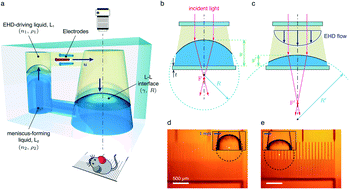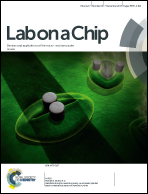Dual-mode reconfigurable focusing using the interface of aqueous and dielectric liquids†
Abstract
An optofluidic lens serves as a highly reconfigurable device to manipulate light by using a smoothly curved interface between immiscible liquids. Here we propose a dielectro-optofluidic lens (DOL) that is capable of dual-mode reconfigurable focusing. In this DOL, light focuses through a dielectric liquid–aqueous liquid interface where movement and deformation of the interface are achieved by electrohydrodynamic (EHD) actuation. We initially perform alternating current-EHD actuation of the dielectric liquid to obtain its benefit of frequency-dependent behavior and to prevent electrolysis of the aqueous liquid. Our DOL uniquely operates in two modes, namely, an oscillation mode in the low-frequency regime (<1 Hz) with a 10 mm focus-tuning range and a static mode in the high-frequency regime (>10 Hz) with a 1 mm focus-tuning range, which are easily modulated on demand by the frequency range of the applied voltage. We successfully conduct proof-of-concept experiments, including extending the depth-of-field using the oscillation mode to clearly visualize thick targets, and integrating the proposed DOL with a photoacoustic microscope using the static mode to adjust the focal point.



 Please wait while we load your content...
Please wait while we load your content...